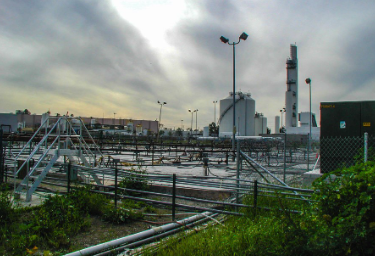SITE BACKGROUND
The Site was a bulk chemical repackaging facility from 1976-1986. Chemicals were stored in both above ground and underground storage tanks and piped to packaging areas. Bulk chemicals were transported to and from the facility by truck and rail. The site has been largely vacant since operations ceased in 1986.
GEOLOGY AND HYDROGEOLOGY
The Site geology consists of layers of silt/clay and sand. In general, the low-permeable silt/clay layers include a surface layer with a depth of approximately 5-10 ft (1.5 -3.0 m) at the source area location. This layer is underlain by 12-20 ft ( 3.7-6.0 m) of sand. Under the sand layer is a 15-20 ft (4.5-6.0 m) thick silt/clay layer, which is underlain by a thick sand layer that extends far below the treatment depth of 65 ft (19.8 m). As a result of the wide range of permeability present (silty clay to sand), a combination of ISTD and SEE was selected.
CHALLENGES AND SOLUTIONS
Although the heating progressed in a relatively predictable fashion, the temperatures in a few shallow locations were slower to reach target temperatures than predicted. This was resolved by adding 16 shallow heaters and a vapor cover over the surface. A vapor cover is a layer of insulation that is installed at some sites to limit water infiltration, create a vapor tight seal and reduce heat losses in a shallow zone. Although a vapor cover is not required at all sites, it was vital during this project to prevent inadequate shallow treatment.
Once the shallow heaters and vapor cover were installed, the heating duration was extended to increase the total mass removal.
PROJECT SUMMARY
The reduction in soil and water concentrations, pre- and post-treatment within the TTZ indicates that overall removal of greater than 99% of the contaminant mass was achieved, with an average reduction of 99.21%. Methylene Chloride showed the best removal rate in soil at 99.99%. Initial concentrations had averaged 43 mg/kg, whereas average concentrations of 0.005 mg/kg were recorded after treatment. The lowest removal rate in soil was 93.39% for 1,1-Dichloroethane. This was due to the fact that initial concentrations of 1,1-Dichloroethane were quite low prior to treatment, averaging only 0.257 mg/kg. After treatment, average total soil concentrations were 0.017 mg/kg. It is estimated that a total over 27,000 lbs (12,300 kg) of contaminant mass were removed from the soil over the 10 month thermal treatment period.
